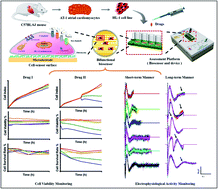High-temporal-range drug-induced cardiac side-effect evaluation using simultaneous HL-1-based impedance and long-term electrophysiology recording systems†
Abstract
Drug-induced cardiac side-effects remain a major cause for the removal of drugs from the market and the termination of significant numbers of drug development projects. Many of the physiological and pharmacological reasons are still unclear. In this study, to comprehensively evaluate the cardiac side-effects of drugs, high-temporal-range evaluation with an HL-1-based impedance and long-term electrophysiology recording platform was proposed. Integrated with microscale interdigitated electrodes (IDEs) and planar microelectrodes, the platform could get reliable cell viability monitoring and extracellular electrophysiology recording simultaneously for low system signal drifting and noise (10 μV) in long-term experiments. HL-1 cardiac muscle cells were used as a target cardiac electrophysiology model because they are, by far, the only cardiomyocytes that can continuously divide while maintaining specific characteristics of adult cardiomyocytes. Vinblastine and nifedipine were introduced to verify the performance of this platform in a different time-dependent manner. According to the extracted cell viability and electrophysiological characteristics including cell impedance (namely, cell index, CI), extracellular field potential (EFP), firing rate (FR), inner-period and period-to-period intervals, the results showed that vinblastine exhibited a relatively strong effect on cell viability (maximum 79.83% decrease after 24 hours) and led to the fluctuation of inner-period intervals in long-term monitoring. In contrast, nifedipine presented a negligible effect on cell viability compared to control groups (maintaining minimum 86.20% of viability on an average after 24 hours), but a shortened QT interval (15.2% at least) was observed immediately. In summary, all the two time-dependent drug-induced results indicated that this HL-1-based impedance and long-term electrophysiology recording platform can not only monitor cell viability through the whole experiment but also possess both quick-reaction and long-term tracking ability for identical requirements, thus providing a promising and useful way for drug-induced cardiac side-effect evaluation in a high temporal range.



 Please wait while we load your content...
Please wait while we load your content...